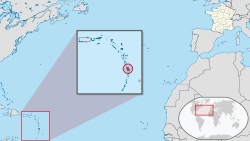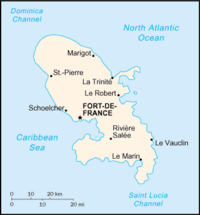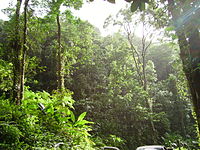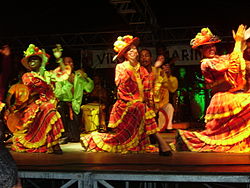
Martinique
Did you know...
SOS Children, which runs nearly 200 sos schools in the developing world, organised this selection. SOS mothers each look after a a family of sponsored children.
| Martinique | |||
|---|---|---|---|
| — Overseas region of France — | |||
|
|||
| Country | |||
| Prefecture | Fort-de-France | ||
| Departments | 1 | ||
| Government | |||
| • President | Serge Letchimy | ||
| Area | |||
| • Total | 1,128 km2 (436 sq mi) | ||
| Population (2007-01-01) | |||
| • Total | 397,730 | ||
| • Density | 350/km2 (910/sq mi) | ||
| Time zone | ECT ( UTC-04) | ||
| GDP/ Nominal | € 7.9 billion (2008) | ||
| GDP per capita | € 19,607 (2008) | ||
| NUTS Region | FR9 | ||
| Website | cr-martinique.fr | ||
Martinique (French pronunciation: [maʁtinik]) is an island in the eastern Caribbean Sea, with a land area of 1,128 km2 (436 sq mi). Like Guadeloupe, it is an overseas region of France, consisting of a single overseas department. To the northwest lies Dominica, to the south St Lucia, and to the southeast Barbados. As with the other overseas departments, Martinique is one of the twenty-six regions of France (being an overseas region) and an integral part of the Republic. The first European to encounter the island was Christopher Columbus in 1502.
As part of France, Martinique is part of the European Union, and its currency is the euro. Its official language is French, although many of its inhabitants also speak Antillean Creole (Créole Martiniquais).
History
Politics
The inhabitants of Martinique are French citizens with full political and legal rights. Martinique sends four deputies to the French National Assembly and two senators to the French Senate.
Subdivisions
Martinique is divided into four arrondissements, 34 communes, and 45 cantons.
Geography
Location: Caribbean, island in the Caribbean Sea, north of Trinidad and Tobago
Geographic coordinates: 14°40′N 61°00′W
Map references: Central America and the Caribbean
Area:
total: 1,100 square kilometres (420 sq mi)
land: 1,060 square kilometres (410 sq mi)
water: 40 square kilometres (15 sq mi)
Environment
The north of the island is mountainous and lushly salted. It features four ensembles of pitons (volcanoes) and mornes (mountains): the Piton Conil on the extreme North, which dominates the Dominica Channel; Mount Pelée, an active volcano; the Morne Jacob; and the Pitons du Carbet, an ensemble of five extinct volcanoes covered with rainforest and dominating the Bay of Fort de France at 1,196 metres (3,924 ft).
The highest of the island's many mountains, at 1,397 metres (4,583 ft), is the famous volcano Mount Pelée. Its volcanic ash has created gray and black sand beaches in the north (in particular between Anse Ceron and Anse des Gallets), contrasting markedly from the white sands of Les Salines in the south.
The south is more easily traversed, though it still features some impressive geographic features. Because it is easier to travel and because of the many beaches and food facilities throughout this region, the south receives the bulk of the tourist traffic. The beaches from Pointe de Bout, through Diamant (which features right off the coast of Roche de Diamant), St. Luce, the continent of St. Anne and down to Les Salines are popular.
Economy
Infrastructure
Martinique Aimé Césaire International Airport serves the island.
Demographics
| 1700 estimate |
1738 estimate |
1848 estimate |
1869 estimate |
1873 estimate |
1878 estimate |
1883 estimate |
1888 estimate |
1893 estimate |
1900 estimate |
1954 census |
1961 census |
1967 census |
1974 census |
1982 census |
1990 census |
1999 census |
2006 census |
2007 estimate |
2008 estimate |
|---|---|---|---|---|---|---|---|---|---|---|---|---|---|---|---|---|---|---|---|
| 24,000 | 74,000 | 120,400 | 152,925 | 157,805 | 162,861 | 167,119 | 175,863 | 189,599 | 203,781 | 239,130 | 292,062 | 320,030 | 324,832 | 328,566 | 359,572 | 381,427 | 397,732 | 400,000 | 402,000 |
| Official figures from past censuses and INSEE estimates. | |||||||||||||||||||
Culture
As an overseas département of France, Martinique's culture blends French and Caribbean influences. The city of Saint-Pierre (destroyed by a volcanic eruption of Mount Pelée), was often referred to as the "Paris of the Lesser Antilles". Following traditional French custom, many businesses close at midday to allow a lengthy lunch, then reopen later in the afternoon. The official language is French.
Many Martinicans speak Martiniquan Creole, a subdivision of Antillean Creole that is virtually identical to the varieties spoken in neighboring English-speaking islands of Saint Lucia and Dominica. Martinique's Creole is based on French and African languages with elements of English, Spanish, and Portuguese. It continues to be used in oral storytelling traditions and other forms of speech and to a lesser extent in writing. Its use is predominant among friends and close family. Though it is normally not used in professional situations, members of the media and politicians have begun to use it more frequently as a way to redeem national identity and prevent cultural assimilation by mainland France. For the most part, the local Creole is not immediately intelligible to speakers of Standard French, due to significant differences in grammar and pronunciation.
Most of Martinique's population is descended from enslaved Africans brought to work on sugar plantations during the colonial era, generally mixed with some French, Amerindian (Carib people), Indian (Tamil), Lebanese or Chinese ancestry. Between 5 and 10% of the population is of Indian (Tamil) origin. The island also boasts a small Syro- Lebanese community, a small but increasing Chinese community, and the Béké community, descendants of European ethnic groups of the first French and British settlers, who still dominate parts of the agricultural and trade sectors of the economy. Whites represent 5% of the population.
The Béké people (which totals around 5,000 people in the island, most of them of aristocratic origin by birth or after buying the title) generally live in mansions on the Atlantic coast of the island (mostly in the François - Cap Est district). In addition to the island population, the island hosts a metropolitan French community, most of which lives on the island on a temporary basis (generally from 3 to 5 years).
There are an estimated 260,000 people of Martiniquan origin living in mainland France, most of them in the Paris region.
Today, the island enjoys a higher standard of living than most other Caribbean countries. French products are easily available, from Chanel fashions to Limoges porcelain. Studying in the métropole (mainland France, especially Paris) is common for young adults. Martinique has been a vacation hotspot for many years, attracting both upper-class French and more budget-conscious travelers.
Martinique has a hybrid cuisine, mixing elements of African, French, Carib Amerindian and South Asian traditions. One of its most famous dishes is the Colombo (compare Tamil word kuzhambu for gravy or broth), a unique curry of chicken (curry chicken), meat or fish with vegetables, spiced with a distinctive masala of Tamil origins, sparked with tamarind, and often containing wine, coconut milk, cassava and rum. A strong tradition of Martiniquan desserts and cakes incorporate pineapple, rum, and a wide range of local ingredients.
In popular culture
- Martinique is the main setting of the 1944 film To Have and Have Not starring Humphrey Bogart and Lauren Bacall.
- The island is mentioned in the song "Uffington wassail" by Half Man Half Biscuit.
- In the gothic soap opera Dark Shadows, the characters of Angelique Bouchard Collins, Josette du Pres, and Josette's family are from Martinique.
- Martinique was featured in the 1999 remake of The Thomas Crown Affair, and in the movie Sugar Cane Alley.
- Setting of Caridad Bravo Adams' novel Corazón Salvaje.
- Much of the 1979 Italian thriller Concorde Affaire '79 took place on and around the island.
- The Bugs Bunny cartoon " 8 Ball Bunny"' saw Bugs and a showbiz penguin called Playboy stranded on Martinique.
- "Martinique Blue" was a popular colour used by automotive builder Pontiac, a division of General Motors, on 1978 Firebirds and Trans Ams. Also known as cowl tag colour code 24.







